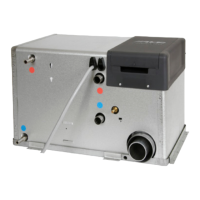> 200 mm
Figure D
7
8
TOP OBEN
10b
9
11
10a
NOTE! If the surface is of
contoured type, such as
hammered sheet metal, an
automotive body sealant
must be used around the
gasket (D.7).
Wall
Floor
Roof
5:5 FITTING A WALL FLUE
• The boiler must be mounted together with the Alde original wall ue, never mount the wall ue to oor or roof. The
ue must not be blocked. In choosing the location, bear in mind that there must always be adequate ventilation of
exhaust gases into the open air.
• The wall ue should be mounted on as at a surface as possible, allowing air to circulate freely past the ue.
• There must be a minimum lateral distance of 200 mm from any projecting item.
• There must be a minimum lateral distance of 300 mm from a window that can be opened or a ventilation air intake.
The ue must not be mounted under a window that can be opened or a ventilation air intake; see drawing below.
If the ue is to be tted closer than the dimensions above, a window switch (Part. no. 3010 280) must be tted that
stops LPG operation when the window is open. To ensure the boiler works as intended, no item should be tted within
a radius of 300 mm around the ue (not a legal requirement). National regulations must always be followed.
• The distance from the ue to a ventilation air intake under the vehicle should be at least 300 mm.
• The distance from the ue to a lling point or ventilation for fuel must be at least 500 mm.
• Mark up where the ue is to be located. Then drill a Ø 83 mm hole through the outer wall. First, t the gasket
(Figure D 7), and then screw the ue (Figure D 8) securely in place with the six self-tapping screws (Figure D 9).
If the surface is of contoured type, such as hammered sheet metal, an automotive body sealant must be used
around the gasket. Note that the ue must be tted with the elbow pointing upwards, the ue is also marked
TOP OBEN. Then, t the plastic cap (Figure D 10a) and the O-ring (Figure D 10b), using the two enclosed screws
(Illustrated D 11)
CARBON MONOXIDE POISONING
This heating system can produce dangerous carbon
monoxide (CO) gas when using the LPG operation if it
is not installed and used properly.

